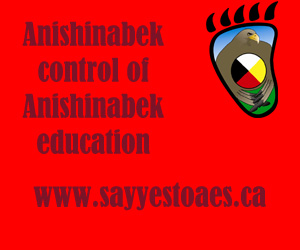An Anishinabek Education System will bring knowledge, identity and pride to our kids
SAULT STE. MARIE — “The current option for our children’s education isn’t working and we need to remind all of our citizens that this is why we need the Anishinabek Education System,” says Marnie Yourchuk, Education Manager for Mamaweswen, North Shore Tribal Council.
Yourchuk says that a low graduation rate for First Nations is a big reason why we need an education system that works for our children.
Grand Council Chief Patrick Madahbee points out that racism, lack of self-esteem, lack of culture, not knowing our language are all factors as to why the current system just does not work for our kids.
“We can turn that all around by implementing our Anishinabek Education System,” says Madahbee. “We have to do this for our children’s future — to maintain their Anishinaabe identity.”
The first round of regional information sessions on the proposed Anishinabek Nation Education Agreement with Canada started today preparing Anishinabek Nation citizens for the upcoming ratification vote to be held Nov. 28 – Dec. 2, 2016.
Andrew Arnott, Fiscal Negotiator for the Union of Ontario Indians says that the intent is to have votes in all of the communities.
“Anishinabek Nation citizens will be able to vote by mail-in ballot as well,” says Arnott. “So far we have 30 communities who have agreed to be part of this process.”
Madahbee says that he’s confident that up to 35 communities might be part of the voting process since there is a lot of interest.
One of the challenges will be is to make sure that the First Nations have updated addresses for our citizens so that they will be able to vote.
“The most important component of the Anishinabek Education System are the Regional Education Councils that feed into the Kinoomaadziwin Education Body,” says Madahbee. “Once this system is ours, it will be a community-driven system.” In this round of community and regional meetings, the Regional Communications Coordinators will be setting up meetings to introduce the proposed Anishinabek Nation Education Agreement with Canada and finding out more about the Anishinabek Education System.
The Regional Communications teams will be going into the communities and having more regional sessions in urban centres to reach out to citizens to learn more about the agreement, learn about the vote and give them the opportunity to vote in the fall.
To find out more, visit www.sayyestoaes.ca



